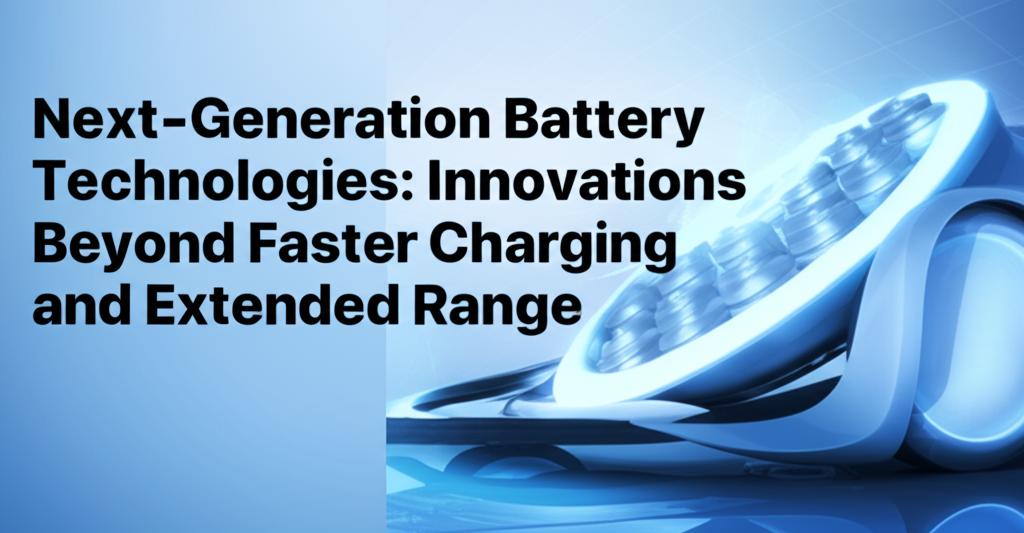While the pursuit of faster charging and longer range continues to dominate headlines, the next generation of battery technologies is quietly evolving to address a much broader spectrum of challenges and opportunities. Innovations are emerging that focus on enhancing safety, improving sustainability, reducing costs, and enabling entirely new applications. Here’s a look at some of the key advancements shaping the future of energy storage beyond the usual metrics.
Enhanced Safety and Sustainability
A significant driver in battery innovation is the increasing demand for safer and more environmentally friendly energy storage solutions.
- Solid-State Batteries: These batteries are a major focus, replacing the liquid electrolytes found in traditional lithium-ion batteries with solid materials. This design change inherently improves safety by reducing the risk of flammability and thermal runaway. Companies like Toyota, Samsung, Farasis Energy, and Microvast are making strides in developing and scaling up production of solid-state batteries, which also promise higher energy density. ProLogium's lithium ceramic battery, for example, features a fully inorganic design for better performance in extreme temperatures and enhanced safety.
- Quasi-Solid-State Batteries: Researchers are developing quasi-solid-state lithium-ion batteries that blend non-flammable solid and liquid electrolytes. This approach aims to tackle both flammability issues and the shorter lifespan of conventional lithium-ion batteries by improving ionic conductivity and reducing fire risk.
- Cobalt-Free Chemistries: The reliance on cobalt in lithium-ion batteries has raised ethical sourcing and supply chain concerns, not to mention cost volatility. Innovations are leading to cobalt-free lithium-ion batteries, making them more sustainable and cost-effective.
- Sustainable Materials and Recycling: There's a growing emphasis on using more abundant and eco-friendly materials. This includes anodes made from burnt rice hulls or chitosan from crab shells. Furthermore, advancements in battery recycling technologies are crucial. "Debond on demand" technology, for example, allows for easier disassembly of battery packs, facilitating the reuse and recycling of materials, contributing to a circular economy. Efficient processes for extracting critical minerals like lithium, nickel, and cobalt from old batteries are being developed to reduce mining and its environmental impact. The EU Batteries Regulation, set to take effect in 2025, mandates more sustainable battery designs, aiming to reduce carbon footprints and increase recycling rates.
- Paper-Based Batteries: Startups like Flint are developing paper-based batteries that incorporate paper as a key material to lower manufacturing costs and environmental impact. These batteries, with flexible and biodegradable paper electrodes, could power small, disposable electronics without generating toxic waste.
Cost Reduction and Material Innovation
Making batteries more affordable and less reliant on scarce materials is a key goal.
- Sodium-Ion Batteries: As a more abundant and cost-effective alternative to lithium, sodium is gaining significant attention. Sodium-ion batteries are emerging as a viable option for applications like grid-scale energy storage and even some electric vehicles (EVs), particularly for budget models. Companies like CATL and HiNa Battery are advancing this technology, with CATL planning large-scale production of its second-generation sodium-ion batteries that boast improved energy density and performance in extreme temperatures. These batteries are expected to reach cost parity with lithium-iron-phosphate (LFP) batteries.
- Silicon Anodes: Replacing traditional graphite anodes with silicon can theoretically increase energy capacity tenfold. Silicon anodes allow batteries to store significantly more energy, potentially leading to longer ranges and faster charging. Companies like Sila Nanotechnologies are developing silicon-based anode materials that can be dropped into existing lithium-ion battery manufacturing processes, boosting energy capacity.
- Lithium-Sulfur Batteries: These batteries offer the potential for higher energy density at a lower cost due to the abundance of sulfur. They are also more environmentally friendly than traditional lithium-ion batteries. While challenges like corrosion and conductivity remain, research is ongoing to overcome these hurdles.
- Abundant Element Batteries: Beyond sodium, researchers are exploring other abundant elements for battery chemistries, such as aluminum-ion, zinc-sulfur, and oxygen-ion batteries.
New Applications and Enhanced Performance Characteristics
Innovations are also paving the way for batteries to be used in novel ways and perform better under specific conditions.
- Long-Duration Energy Storage (LDES): New battery technologies are crucial for bridging the gap in LDES, which is essential for grid stability as reliance on intermittent renewable energy sources like solar and wind increases.
- Extreme Temperature Performance: Some new battery formulations, like certain sodium-ion and lithium ceramic batteries, offer reliable operation in extreme temperatures, which is critical for various applications, from EVs in cold climates to industrial equipment.
- Flexibility and Form Factor: Paper-based batteries and other flexible designs could enable new applications in wearables, smart packaging, and disposable medical sensors.
- Specialized Applications:
Urban Air Mobility: Lithium-sulfur batteries are being developed with the capacity to power next-generation eVTOLs (electric vertical take-off and landing aircraft) and drone taxis.
Micro-Sensors and Disposable Electronics: Paper batteries offer a compostable and affordable power source for single-use or specialized applications like medical patches.
* Nuclear Waste-Powered Batteries: Researchers are exploring novel concepts like batteries that can convert energy from nuclear waste into electricity using scintillator crystals and solar cells, potentially powering microelectronics.
- Smart Battery Management Systems (BMS): Integrating AI and IoT, next-generation BMS can optimize battery operations, monitor performance in real-time for individual cells, enhance safety by preventing overheating and short circuits, and predict maintenance needs, thereby extending battery life.
The landscape of battery technology is rapidly diversifying. While faster charging and extended range remain important, the next wave of innovations is set to deliver batteries that are safer, more sustainable, more affordable, and tailored for a wider array of applications, truly powering a cleaner and more electrified future.

